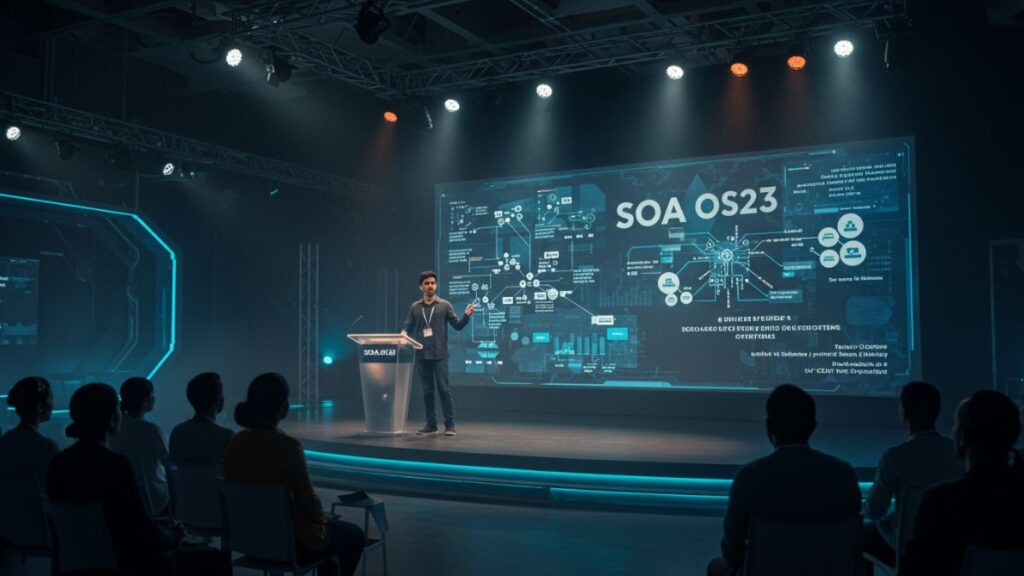In the rapidly evolving landscape of enterprise technology, staying ahead means embracing systems that are scalable, flexible, and efficient. One such advancement is SOA OS23, a next-generation development in Service-Oriented Architecture (SOA). As businesses worldwide lean into digital transformation, SOA OS23 is gaining attention for its innovative approach to service integration, communication, and orchestration.
What is SOA OS23?
SOA OS23 stands for the Service-Oriented Architecture Operating System 2023 edition. It is not just an update but a comprehensive evolution of traditional SOA frameworks, designed to meet the demands of modern applications, cloud environments, and hybrid infrastructures.
SOA, at its core, is an architectural pattern in which application components provide services to other components via a communication protocol over a network. With SOA OS23, the emphasis is on enhanced interoperability, AI-driven automation, and cloud-native adaptability.
The Key Features of SOA OS23
SOA OS23 comes packed with several innovations that make it ideal for large-scale enterprise operations:
1. Cloud-Native Compatibility
One of the most significant upgrades in SOA OS23 is its deep integration with cloud-native platforms such as Kubernetes and Docker. It supports containerized services, allowing businesses to scale their applications efficiently and deploy updates with minimal downtime.
2. Event-Driven Architecture
SOA OS23 supports an event-driven model, making it highly responsive and asynchronous. This model allows services to react in real-time to triggers and changes, improving performance and user experience across the board.
3. Built-In AI and Automation
Unlike traditional SOA systems, OS23 incorporates AI-driven process automation. This enables smarter service orchestration, predictive maintenance, and automated decision-making, reducing the need for manual intervention in routine tasks.
4. Enhanced Security Protocols
Security has always been a concern with interconnected systems. SOA OS23 addresses this by offering advanced encryption standards, zero-trust architecture, and real-time threat monitoring, ensuring robust protection against data breaches and cyberattacks.
Why SOA Still Matters
Some may argue that the rise of microservices and serverless computing has overshadowed traditional SOA. However, SOA remains relevant, especially for legacy system integration and enterprise-level resource management. SOA OS23 acts as a bridge between legacy systems and modern architecture, providing a hybrid solution that maintains stability while enabling innovation.
SOA OS23’s modular approach allows enterprises to retain existing infrastructure while gradually introducing new functionalities—without causing major disruptions to operations.
SOA OS23 vs. Traditional SOA
Here’s a quick comparison to show how far SOA OS23 has come from earlier versions:
| Feature | Traditional SOA | SOA OS23 |
|---|---|---|
| Deployment Style | On-premise | Cloud-native + On-prem |
| Service Communication | SOAP/HTTP | REST, gRPC, MQTT |
| Scalability | Moderate | Auto-scalable |
| Security | Basic XML Security | AI-Driven Security |
| Integration | Manual middleware | Plug-and-play modules |
As seen above, SOA OS23 is optimized for today’s computing environments, offering better scalability, easier integration, and enhanced performance.
Real-World Applications of SOA OS23
Businesses across industries are already benefiting from implementing SOA OS23. Here are a few real-world use cases:
1. Healthcare
Hospitals and health systems use SOA OS23 to connect patient data across departments, labs, and third-party systems like insurance providers. The real-time data exchange improves patient care and reduces administrative overhead.
2. Banking and Finance
Financial institutions leverage SOA OS23 for secure transaction processing and fraud detection. Its ability to handle high volumes of data with minimal latency makes it ideal for high-stakes environments.
3. E-commerce
E-commerce platforms integrate SOA OS23 to manage their order processing, payment gateways, inventory, and CRM systems. It ensures a seamless and unified experience for both users and internal teams.
Challenges in Adopting SOA OS23
Despite its benefits, transitioning to SOA OS23 isn’t without hurdles. Some common challenges include:
-
Migration Complexity: Upgrading from older systems to SOA OS23 can be technically challenging and may require substantial planning.
-
Skill Gap: Enterprises may struggle to find IT professionals who are well-versed in both legacy SOA and newer cloud-native technologies.
-
Initial Investment: Although it saves money in the long run, the upfront cost of deploying SOA OS23 can be significant, especially for smaller businesses.
However, these challenges are often outweighed by the long-term benefits and can be mitigated through proper strategy, training, and phased implementation.
The Future of SOA with OS23
SOA OS23 isn’t the end—it’s the beginning of a new chapter. Future versions are expected to further incorporate quantum computing support, blockchain for secure service chains, and self-healing networks. These enhancements aim to make SOA even more autonomous, adaptive, and resilient.
Moreover, as businesses continue to prioritize interoperability, agility, and data integration, SOA OS23 positions itself as a vital tool in the enterprise digital toolbox.
Conclusion
SOA OS23 is more than an operating system—it’s a robust platform that transforms how services communicate, collaborate, and deliver value. Whether you’re in healthcare, finance, manufacturing, or retail, embracing SOA OS23 can significantly enhance your IT infrastructure’s agility and intelligence.
By marrying the strengths of traditional SOA with cutting-edge technologies, SOA OS23 offers a future-proof solution for enterprises aiming to thrive in the digital age.


